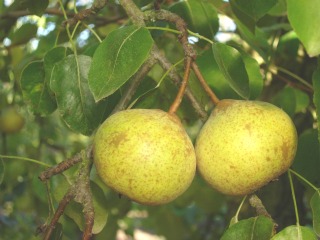
Medieval Fruit Varieties
Variety: Taynton Squash (1700)

Photo - Postman, J., USDA, ARS
Notes:
An early season perry pear with medium acids and tannins. Origin: A very old English cultivar grown in the West Midlands since before 1700. The cultivar name is presumably derived from Taynton, its parish of origin. In his1811 ''Pomona Herefordiensis'' Thomas Andrew Knight wrote of this pear, already considered an old cultivar at that time, that during a favourable season and when well managed 'it affords a much finer liquor than any other pear.' Fruit: Small, oblate or turbinate, 39-45 mm. long, 46-52 mm.; stem slender, 20-27 mm., often fleshy where attached to the fruit; almost no stem basin; calyx basin wide and shallow; calyx open or upright, rarely reflexed. Skin dull greenish yellow, with a brownish-red blush; slight russet at stem end and calyx end; lenticels numerous, small but conspicuous. Flesh white, briskly sweet, with stone cells around core. Ripens mid-late September in England's West Midlands, mid September in western Oregon; does not store well. Tree: Mature tree is medium to large with narrow crotch angles, twiggy; very productive but usually biennial bearing; early flowering; fruit scab often severe. Perry: Fruit milled within two days of harvest; juice acidity 0.45, tannins 0.13, specific gravity 1.058; higher concentration of citric acid than most other perry pears (>.3%); produces an average quality vintage with medium acid and tannin; compared to champagne in older writings. -- Brooks and Olmo Register of Fruit and Nut Varieties.